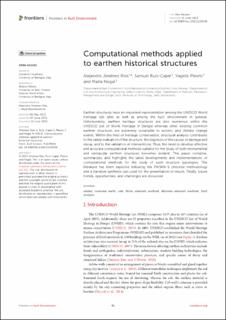| dc.contributor.author | Jiménez Rios, Alejandro | |
| dc.contributor.author | Ruiz-Capel, Samuel | |
| dc.contributor.author | Plevris, Vagelis | |
| dc.contributor.author | Nogal, Maria | |
| dc.date.accessioned | 2024-01-19T08:13:49Z | |
| dc.date.available | 2024-01-19T08:13:49Z | |
| dc.date.created | 2023-07-25T16:13:14Z | |
| dc.date.issued | 2023 | |
| dc.identifier.citation | Frontiers in Built Environment. 2023, . | en_US |
| dc.identifier.issn | 2297-3362 | |
| dc.identifier.uri | https://hdl.handle.net/11250/3112644 | |
| dc.description.abstract | Earthen structures have an important representation among the UNESCO World Heritage List sites as well as among the built environment in general. Unfortunately, earthen heritage structures are also numerous within the UNESCO List of World Heritage in Danger whereas other existing common earthen structures are extremely vulnerable to seismic and climate change events. Within the field of heritage conservation, structural analysis contributes to the safety evaluation of the structure, the diagnosis of the causes of damage and decay, and to the validation of interventions. Thus, the need to develop effective and accurate computational methods suitable for the study of both monumental and vernacular earthen structures becomes evident. This paper compiles, summarizes, and highlights the latest developments and implementations of computational methods for the study of such structure typologies. The literature has been explored following the PRISMA-S checklist methodology and a narrative synthesis was used for the presentation of results. Finally, future trends, opportunities, and challenges are discussed. | en_US |
| dc.language.iso | eng | en_US |
| dc.rights | Navngivelse 4.0 Internasjonal | * |
| dc.rights.uri | http://creativecommons.org/licenses/by/4.0/deed.no | * |
| dc.title | Computational Methods Applied to Earthen Historical Structures | en_US |
| dc.type | Peer reviewed | en_US |
| dc.type | Journal article | en_US |
| dc.description.version | publishedVersion | en_US |
| cristin.ispublished | true | |
| cristin.fulltext | original | |
| cristin.qualitycode | 1 | |
| dc.identifier.doi | 10.3389/fbuil.2023.1219108 | |
| dc.identifier.cristin | 2163544 | |
| dc.source.journal | Frontiers in Built Environment | en_US |
| dc.source.pagenumber | 7 | en_US |

